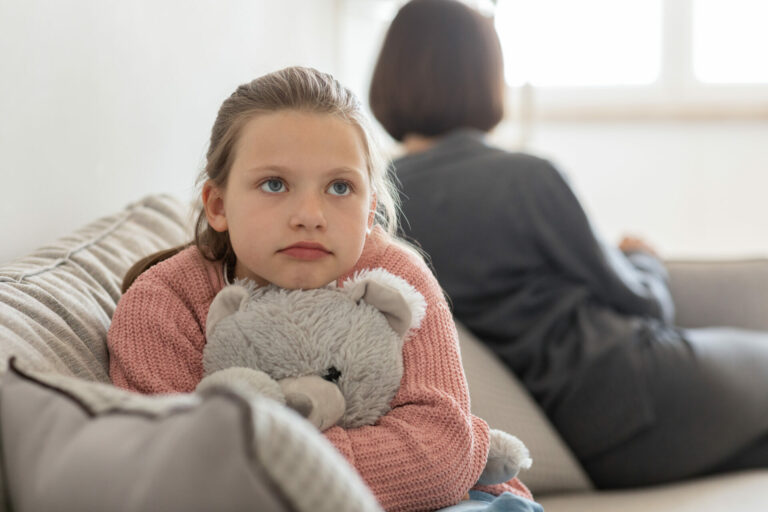The Scary Cycle and Kids in Survival Mode
By Alex Biddell, Intern Clinical | February 09, 2024
For parents of children that are stuck on “survival mode,” there are difficult times with their kids when they may think “My child will never learn,” “I feel guilty,” or even “I should know how to handle this.” Yes, parenting a child that lives in “survival mode” can be stressful, but a dysregulated child can make for a dysregulated parent if that parent doesn’t have the right frame of mind. However, it is the mindful parent that is aware of their own state (physical, mental, emotional, spiritual, and so on) that can be calm when a child is facing the chaos of their own trauma.
Wesselman, Schweitzer, and Armstrong (2014) make it a point to talk about a cycle that happens when a parent does not have the right mindset when their children’s “Survival Mode” switch is turned on. The cycle goes from “scared child” to “scary child” to “scared parents” to “scary parents.” Firstly, it is important to remember that a child’s maladaptive behaviors come from a place of trauma (Wesselman et al., 2014.) This means that the cycle starts when the child is scared because they faced a trigger that reminds them of their trauma. When a child is scared, their reaction is to respond with negative behaviors that they know protect them such as lashing out to keep people away (Wesselman et al., 2014). The scared child has become “the scary child,” the second phase of this cycle. And when a parent does not act mindfully in response to this, they will likely react instinctively and become the “scared parent.”
A “scared parent” can become defensive and may feel like they need to regain control. This can lead to an escalation of the incident when the parent reacts with survival mechanics of their own and becomes “the scary parent” (Wesselman et al., 2014.) “The scary parent” may react to their child’s behaviors by raising their voice, exhibiting more aggressive body language, casting punishment without giving a reason, and so on. A child in “survival mode” will likely receive this negatively and try to cope accordingly by continuing to escalate the conflict, emotionally shutting down, or running away to a place they consider safe and isolated. The emotion might be shown this way, but it doesn’t allow for any helpful growth (Wesselman et al., 2014). The parent-child bond does not strengthen this way.
So why go through this “scary cycle” if it isn’t a productive way to parent a child in “survival mode?” Simply put, it feels like the easiest way to handle things. Humans are emotional people, and when something upsets a person, they are going to want to let it out. When kids frustrate their parents, are the parents happy about being frustrated? Probably not. But how those parents process that frustration and how they respond is what makes the difference. All this is to say that the “scary cycle” is one that comes naturally to people. But also know that the cycle can be broken with proper mindfulness, intentionality, and compassion.
For parents of children that are stuck on “survival mode,” there are difficult times with their kids when they may think “My child will never learn,” “I feel guilty,” or even “I should know how to handle this.” Yes, parenting a child that lives in “survival mode” can be stressful, but a dysregulated child can make for a dysregulated parent if that parent doesn’t have the right frame of mind. However, it is the mindful parent that is aware of their own state (physical, mental, emotional, spiritual, and so on) that can be calm when a child is facing the chaos of their own trauma.
Wesselman, Schweitzer, and Armstrong (2014) make it a point to talk about a cycle that happens when a parent does not have the right mindset when their children’s “Survival Mode” switch is turned on. The cycle goes from “scared child” to “scary child” to “scared parents” to “scary parents.” Firstly, it is important to remember that a child’s maladaptive behaviors come from a place of trauma (Wesselman et al., 2014.) This means that the cycle starts when the child is scared because they faced a trigger that reminds them of their trauma. When a child is scared, their reaction is to respond with negative behaviors that they know protect them such as lashing out to keep people away (Wesselman et al., 2014). The scared child has become “the scary child,” the second phase of this cycle. And when a parent does not act mindfully in response to this, they will likely react instinctively and become the “scared parent.”
A “scared parent” can become defensive and may feel like they need to regain control. This can lead to an escalation of the incident when the parent reacts with survival mechanics of their own and becomes “the scary parent” (Wesselman et al., 2014.) “The scary parent” may react to their child’s behaviors by raising their voice, exhibiting more aggressive body language, casting punishment without giving a reason, and so on. A child in “survival mode” will likely receive this negatively and try to cope accordingly by continuing to escalate the conflict, emotionally shutting down, or running away to a place they consider safe and isolated. The emotion might be shown this way, but it doesn’t allow for any helpful growth (Wesselman et al., 2014). The parent-child bond does not strengthen this way.
So why go through this “scary cycle” if it isn’t a productive way to parent a child in “survival mode?” Simply put, it feels like the easiest way to handle things. Humans are emotional people, and when something upsets a person, they are going to want to let it out. When kids frustrate their parents, are the parents happy about being frustrated? Probably not. But how those parents process that frustration and how they respond is what makes the difference. All this is to say that the “scary cycle” is one that comes naturally to people. But also know that the cycle can be broken with proper mindfulness, intentionality, and compassion.
Lecturas recomendadas
References
Wesselman, D., Schweitzer, C., & Armstrong, S. (2014). Integrative Parenting: Strategies for Raising Children Affected by Attachment Trauma. W.W. Norton, New York.
Wesselman, D., Schweitzer, C., & Armstrong, S. (2014). Integrative Team Treatment for Attachment Trauma in Children: Family Therapy and EMDR. W.W. Norton, New York.
References
Wesselman, D., Schweitzer, C., & Armstrong, S. (2014). Integrative Parenting: Strategies for Raising Children Affected by Attachment Trauma. W.W. Norton, New York.
Wesselman, D., Schweitzer, C., & Armstrong, S. (2014). Integrative Team Treatment for Attachment Trauma in Children: Family Therapy and EMDR. W.W. Norton, New York.




